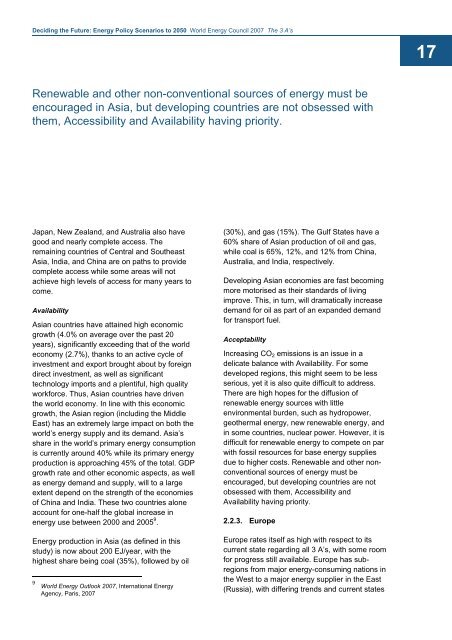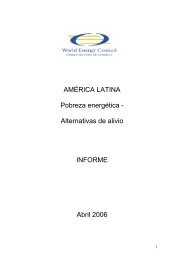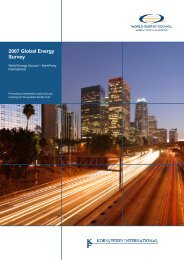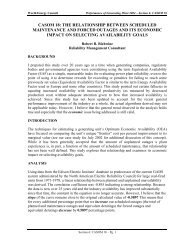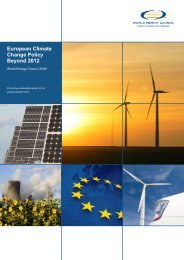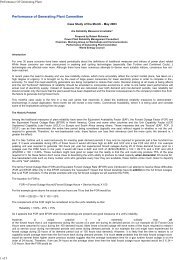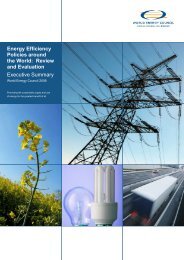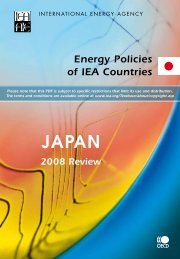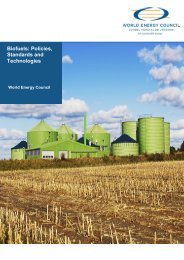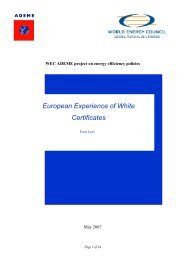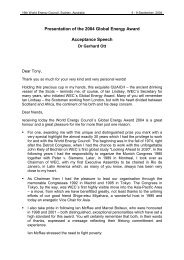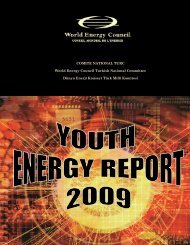Deciding the Future: Energy Policy Scenarios to 2050
Deciding the Future: Energy Policy Scenarios to 2050
Deciding the Future: Energy Policy Scenarios to 2050
You also want an ePaper? Increase the reach of your titles
YUMPU automatically turns print PDFs into web optimized ePapers that Google loves.
<strong>Deciding</strong> <strong>the</strong> <strong>Future</strong>: <strong>Energy</strong> <strong>Policy</strong> <strong>Scenarios</strong> <strong>to</strong> <strong>2050</strong> World <strong>Energy</strong> Council 2007 The 3 A’s<br />
17<br />
Renewable and o<strong>the</strong>r non-conventional sources of energy must be<br />
encouraged in Asia, but developing countries are not obsessed with<br />
<strong>the</strong>m, Accessibility and Availability having priority.<br />
Japan, New Zealand, and Australia also have<br />
good and nearly complete access. The<br />
remaining countries of Central and Sou<strong>the</strong>ast<br />
Asia, India, and China are on paths <strong>to</strong> provide<br />
complete access while some areas will not<br />
achieve high levels of access for many years <strong>to</strong><br />
come.<br />
Availability<br />
Asian countries have attained high economic<br />
growth (4.0% on average over <strong>the</strong> past 20<br />
years), significantly exceeding that of <strong>the</strong> world<br />
economy (2.7%), thanks <strong>to</strong> an active cycle of<br />
investment and export brought about by foreign<br />
direct investment, as well as significant<br />
technology imports and a plentiful, high quality<br />
workforce. Thus, Asian countries have driven<br />
<strong>the</strong> world economy. In line with this economic<br />
growth, <strong>the</strong> Asian region (including <strong>the</strong> Middle<br />
East) has an extremely large impact on both <strong>the</strong><br />
world’s energy supply and its demand. Asia’s<br />
share in <strong>the</strong> world’s primary energy consumption<br />
is currently around 40% while its primary energy<br />
production is approaching 45% of <strong>the</strong> <strong>to</strong>tal. GDP<br />
growth rate and o<strong>the</strong>r economic aspects, as well<br />
as energy demand and supply, will <strong>to</strong> a large<br />
extent depend on <strong>the</strong> strength of <strong>the</strong> economies<br />
of China and India. These two countries alone<br />
account for one-half <strong>the</strong> global increase in<br />
energy use between 2000 and 2005 9 .<br />
<strong>Energy</strong> production in Asia (as defined in this<br />
study) is now about 200 EJ/year, with <strong>the</strong><br />
highest share being coal (35%), followed by oil<br />
9<br />
World <strong>Energy</strong> Outlook 2007, International <strong>Energy</strong><br />
Agency, Paris, 2007<br />
(30%), and gas (15%). The Gulf States have a<br />
60% share of Asian production of oil and gas,<br />
while coal is 65%, 12%, and 12% from China,<br />
Australia, and India, respectively.<br />
Developing Asian economies are fast becoming<br />
more mo<strong>to</strong>rised as <strong>the</strong>ir standards of living<br />
improve. This, in turn, will dramatically increase<br />
demand for oil as part of an expanded demand<br />
for transport fuel.<br />
Acceptability<br />
Increasing CO 2 emissions is an issue in a<br />
delicate balance with Availability. For some<br />
developed regions, this might seem <strong>to</strong> be less<br />
serious, yet it is also quite difficult <strong>to</strong> address.<br />
There are high hopes for <strong>the</strong> diffusion of<br />
renewable energy sources with little<br />
environmental burden, such as hydropower,<br />
geo<strong>the</strong>rmal energy, new renewable energy, and<br />
in some countries, nuclear power. However, it is<br />
difficult for renewable energy <strong>to</strong> compete on par<br />
with fossil resources for base energy supplies<br />
due <strong>to</strong> higher costs. Renewable and o<strong>the</strong>r nonconventional<br />
sources of energy must be<br />
encouraged, but developing countries are not<br />
obsessed with <strong>the</strong>m, Accessibility and<br />
Availability having priority.<br />
2.2.3. Europe<br />
Europe rates itself as high with respect <strong>to</strong> its<br />
current state regarding all 3 A’s, with some room<br />
for progress still available. Europe has subregions<br />
from major energy-consuming nations in<br />
<strong>the</strong> West <strong>to</strong> a major energy supplier in <strong>the</strong> East<br />
(Russia), with differing trends and current states


